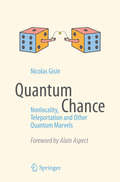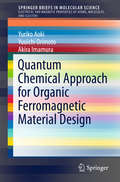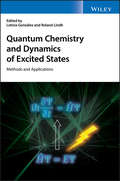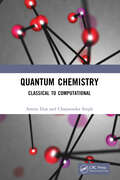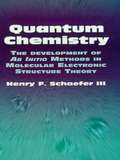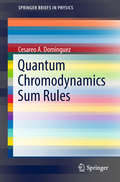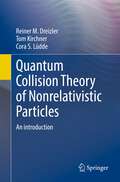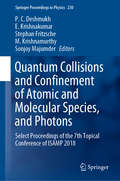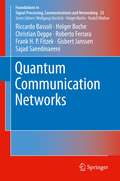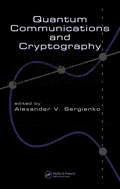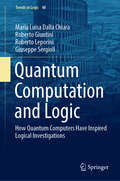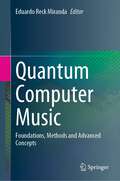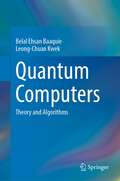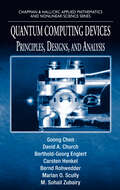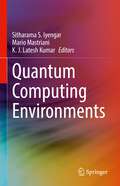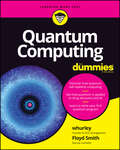- Table View
- List View
Quantum Chance
by Nicolas GisinQuantum physics, which offers an explanation of the world on the smallest scale, has fundamental implications that pose a serious challenge to ordinary logic. Particularly counterintuitive is the notion of entanglement, which has been explored for the past 30 years and posits an ubiquitous randomness capable of manifesting itself simultaneously in more than one place. This amazing 'non-locality' is more than just an abstract curiosity or paradox: it has entirely down-to-earth applications in cryptography, serving for example to protect financial information; it also has enabled the demonstration of 'quantum teleportation', whose infinite possibilities even science-fiction writers can scarcely imagine. This delightful and concise exposition does not avoid the deep logical difficulties of quantum physics, but gives the reader the insights needed to appreciate them. From 'Bell's Theorem' to experiments in quantum entanglement, the reader will gain a solid understanding of one of the most fascinating areas of contemporary physics.
Quantum Chance: Nonlocality, Teleportation and Other Quantum Marvels
by Nicolas GisinQuantum physics, which offers an explanation of the world on the smallest scale, has fundamental implications that pose a serious challenge to ordinary logic. Particularly counterintuitive is the notion of entanglement, which has been explored for the past 30 years and posits an ubiquitous randomness capable of manifesting itself simultaneously in more than one place.This amazing 'non-locality' is more than just an abstract curiosity or paradox: it has entirely down-to-earth applications in cryptography, serving for example to protect financial information; it also has enabled the demonstration of 'quantum teleportation', whose infinite possibilities even science-fiction writers can scarcely imagine.This delightful and concise exposition does not avoid the deep logical difficulties of quantum physics, but gives the reader the insights needed to appreciate them. From 'Bell's Theorem' to experiments in quantum entanglement, the reader will gain a solid understanding of one of the most fascinating areas of contemporary physics.
Quantum Chemical Approach for Organic Ferromagnetic Material Design
by Yuriko Aoki Yuuichi Orimoto Akira ImamuraThis brief provides an overview of theoretical research in organic ferromagnetic material design using quantum chemical approaches based on molecular orbital theory from primary H#65533;ckel to ab initio levels of theory. Most of the content describes the authors' approach to identify simple and efficient guidelines for magnetic design, which have not been described in other books. Individual chapters cover quantum chemistry methods that may be used to find hydrocarbon systems with degenerate non-bonding molecular orbitals that interact with each other, to identify high-spin-preferred systems using an analytical index that allows for simple design of high-spin systems as well as to analyze the effect of high-spin stability through orbital interactions. The extension of these methods to large systems is discussed. This book is a valuable resource for students and researchers who are interested in quantum chemistry related to magnetic property.
Quantum Chemistry
by M. S. RaoQuantum Chemistry provides a coherent and structured approach in introducing the concept of 'quantum' to the students of quantum mechanics. An attempt is made to bring out the subtleties of quantum mechanics, hidden in its abstract laws and equations, applicable to the atomic domain by showing its relevance to the observable macroscopic world as well. The book will help students dispel the stigma associated with quantum mechanics. The emphasis on conceptual approach provides a platform to stand on, and a stimulus to pursue higher quantum mechanics—the doorway to the all-pervasive quantum world. Print edition not for sale in South Asia (India, Sri Lanka, Nepal, Bangladesh, Pakistan or Bhutan).
Quantum Chemistry Simulation of Biological Molecules
by Eudenilson L. Albuquerque Umberto L. Fulco Ewerton W. Caetano Valder N. FreireNano-biotechnology crosses the boundaries between physics, biochemistry and bioengineering, and has profound implications for the biomedical engineering industry. This book describes the quantum chemical simulation of a wide variety of molecular systems, with detailed analysis of their quantum chemical properties, individual molecular configurations, and cutting-edge biomedical applications. Topics covered include the basic properties of quantum chemistry and its conceptual foundations, the nanoelectronics and thermodynamics of DNA, the optoelectronic properties of the five DNA/RNA nucleobase anhydrous crystals, and key examples of molecular diode prototypes. A wide range of important applications are described, including protein binding of drugs such as cholesterol-lowering, anti-Parkinson and anti-migraine drugs, and recent developments in cancer biology are also discussed. This modern and comprehensive text is essential reading for graduate students and researchers in multidisciplinary areas of biological physics, chemical physics, chemical engineering, biochemistry and bioengineering.
Quantum Chemistry and Dynamics of Excited States: Methods and Applications
by Leticia GonzálezAn introduction to the rapidly evolving methodology of electronic excited states For academic researchers, postdocs, graduate and undergraduate students, Quantum Chemistry and Dynamics of Excited States: Methods and Applications reports the most updated and accurate theoretical techniques to treat electronic excited states. From methods to deal with stationary calculations through time-dependent simulations of molecular systems, this book serves as a guide for beginners in the field and knowledge seekers alike. Taking into account the most recent theory developments and representative applications, it also covers the often-overlooked gap between theoretical and computational chemistry. An excellent reference for both researchers and students, Excited States provides essential knowledge on quantum chemistry, an in-depth overview of the latest developments, and theoretical techniques around the properties and nonadiabatic dynamics of chemical systems. Readers will learn: ● Essential theoretical techniques to describe the properties and dynamics of chemical systems ● Electronic Structure methods for stationary calculations ● Methods for electronic excited states from both a quantum chemical and time-dependent point of view ● A breakdown of the most recent developments in the past 30 years For those searching for a better understanding of excited states as they relate to chemistry, biochemistry, industrial chemistry, and beyond, Quantum Chemistry and Dynamics of Excited States provides a solid education in the necessary foundations and important theories of excited states in photochemistry and ultrafast phenomena.
Quantum Chemistry of Nanotubes: Electronic Cylindrical Waves
by Pavel N. D'yachkovThis book gives a detailed and up-to-date overview of the linearized augmented cylindrical wave (LACW) technique for nanotubes and nanowires. The author presents the mathematical foundations together with numerous applications. Method for calculating the electronic structure of point impurities, which is based on a combination of the LACW and Green’s functions techniques, is presented. The book clearly demonstrates how the relativistic effects can be incorporated into LACW approach and how the spin-orbit coupling effects change the tubules band structure. Extensive illustrations of application to the inorganic nanotubes and nanowires make the book essential reading in this field above all.
Quantum Chemistry of Solids
by Robert A. EvarestovQuantum Chemistry of Solids delivers a comprehensive account of the main features and possibilities of LCAO methods for the first principles calculations of electronic structure of periodic systems. The first part describes the basic theory underlying the LCAO methods applied to periodic systems and the use of Hartree-Fock(HF), Density Function theory(DFT) and hybrid Hamiltonians. The translation and site symmetry consideration is included to establish connection between k-space solid -state physics and real-space quantum chemistry. The inclusion of electron correlation effects for periodic systems is considered on the basis of localized crystalline orbitals. The possibilities of LCAO methods for chemical bonding analysis in periodic systems are discussed. The second part deals with the applications of LCAO methods for calculations of bulk crystal properties, including magnetic ordering and crystal structure optimization. In the second edition two new chapters are added in the application part II of the book. Chapter 12 deals with the recent LCAO calculations and illustrates the efficiency of the scalar-relativistic LCAO method for solids, containing heavy atoms. Chapter 13 deals with the symmetry properties and the recent applications of LCAO method to inorganic nanotubes. New material is added to chapter 9 devoted to LCAO calculations of perfect-crystal properties. The possibilities of LCAO method for calculation of the high-frequency dielectric constants of crystals and the description of phase transitions in solids are discussed. The efficiency of LCAO method in the quantum-mechanics-molecular dynamics approach to the interpretation of x-ray absorption and EXAFS spectra is illustrated. A new section is devoted to recent LCAO calculations of electronic, vibrational and magnetic properties of tungstates MeWO4 (Me: Fe,Co,Ni,Cu,Zn,Cd).
Quantum Chemistry: Classical to Computational
by Amita Dua Chayannika SinghThis book discusses major developments of quantum mechanics from classical to computational chemistry.The book is student and user friendly and includes exhaustive derivations, mathematical proofs, and theorems. A series of solved numerical have been added after each topic to have a better understanding of the subject. It will be helpful to Chemistry students at undergraduate and postgraduate level, as well for those appearing in various competitive examinations.Print edition not for sale in South Asia (India, Sri Lanka, Nepal, Bangladesh, Pakistan or Bhutan)
Quantum Chemistry: The Development of Ab Initio Methods in Molecular Electronic Structure Theory
by Henry F. Schaefer IIIThis guide is guaranteed to prove of keen interest to the broad spectrum of experimental chemists who use electronic structure theory to assist in the interpretation of their laboratory findings. A list of 150 landmark papers in ab initio molecular electronic structure methods, it features the first page of each paper (which usually encompasses the abstract and introduction). Its primary focus is methodology, rather than the examination of particular chemical problems, and the selected papers either present new and important methods or illustrate the effectiveness of existing methods in predicting a variety of chemical phenomena.
Quantum Chromodynamics
by B. L. Ioffe V. S. Fadin L. N. LipatovAimed at graduate students and researchers in theoretical physics, this book presents the modern theory of strong interaction: quantum chromodynamics (QCD). The book exposes various perturbative and nonperturbative approaches to the theory, including chiral effective theory, the problems of anomalies, vacuum tunnel transitions, and the problem of divergence of the perturbative series. The QCD sum rules approach is exposed in detail. A great variety of hadronic properties (masses of mesons and baryons, magnetic moments, form factors, quark distributions in hadrons, etc. ) have been found using this method. The evolution of hadronic structure functions is presented in detail, together with polarization phenomena. The problem of jets in QCD is treated through theoretical description and experimental observation. The connection with Regge theory is emphasized. The book covers many aspects of theory which are not discussed in other books, such as CET, QCD sum rules, and BFKL.
Quantum Chromodynamics Sum Rules (SpringerBriefs in Physics)
by Cesareo A. DominguezThis concise book provides the necessary background to allow interested readers to launch original research projects on the subject matter. Currently, this material is not available from one single source, and is either spread out over numerous journal publications, or covered in long and technical monographs. At the core of this book lies the sum rule approach to obtain analytic results in Quantum Chromodynamics (QCD), the current theory of strong interactions among quarks and gluons. This method fully complements Lattice QCD, the corresponding computational approach based on discretizing QCD on a space-time lattice. Applications include standard determinations of hadronic particle properties with extensions to finite temperature and density, and possibly involving the presence of extreme magnetic fields. The latter cases include stellar objects (e.g. neutron stars and magnetars) as well as high-energy proton–proton and heavy-ion collisions. Further topics concern the determination of the fundamental parameters of QCD, e.g. quark masses and the quark–gluon couplings, the hadronic contribution to the anomalous magnetic moment of the muon, and electromagnetic coupling at the the W-boson mass scale.
Quantum Chromodynamics at High Energy
by Yuri V. Kovchegov Eugene LevinFilling a gap in the current literature, this book is the first entirely dedicated to high energy quantum chromodynamics (QCD) including parton saturation and the color glass condensate (CGC). It presents groundbreaking progress on the subject and describes many problems at the forefront of research, bringing postgraduate students, theorists and interested experimentalists up to date with the current state of research in this field. The material is presented in a pedagogical way, with numerous examples and exercises. Discussion ranges from the quasi-classical McLerran-Venugopalan model to the linear BFKL and nonlinear BK/JIMWLK small-x evolution equations. The authors adopt both a theoretical and an experimental outlook, and present the physics of strong interactions in a universal way, making it useful for physicists from various subcommunities of high energy and nuclear physics, and applicable to processes studied at all high energy accelerators around the world. A selection of color figures is available online at www. cambridge. org/9780521112574.
Quantum Codes for Topological Quantum Computation (SpringerBriefs in Mathematics)
by Clarice Dias Albuquerque Eduardo Brandani Silva Waldir Silva Soares Jr.This book offers a structured algebraic and geometric approach to the classification and construction of quantum codes for topological quantum computation. It combines key concepts in linear algebra, algebraic topology, hyperbolic geometry, group theory, quantum mechanics, and classical and quantum coding theory to help readers understand and develop quantum codes for topological quantum computation.One possible approach to building a quantum computer is based on surface codes, operated as stabilizer codes. The surface codes evolved from Kitaev's toric codes, as a means to developing models for topological order by using qubits distributed on the surface of a toroid. A significant advantage of surface codes is their relative tolerance to local errors. A second approach is based on color codes, which are topological stabilizer codes defined on a tessellation with geometrically local stabilizer generators. This book provides basic geometric concepts, like surface geometry, hyperbolic geometry and tessellation, as well as basic algebraic concepts, like stabilizer formalism, for the construction of the most promising classes of quantum error-correcting codes such as surfaces codes and color codes.The book is intended for senior undergraduate and graduate students in Electrical Engineering and Mathematics with an understanding of the basic concepts of linear algebra and quantum mechanics.
Quantum Collision Theory of Nonrelativistic Particles: An Introduction
by Reiner M. Dreizler Tom Kirchner Cora S. LüddeThis book introduces the scattering theory of nonrelativistic systems, a standard tool for interpreting collision experiments with quantum particles at energies not too high. The goal is to explore the interaction between particles and their properties. The authors cover the basics of the theory through a detailed discussion of elastic scattering using the stationary Schrödinger equation and the Lippmann-Schwinger equation. These remarks are supplemented by a consideration of the time-dependent formulation of scattering theory. Selection rules for effective cross sections due to symmetries conditioned by the structure of the interparticle forces and the scattering of spin-polarized particles are discussed. The foundations for the treatment of inelastic processes are laid and explained by application to three-body and nucleotransfer processes.In all chapters, the more technical, mathematical aspect and the more physics-oriented explanations are separated as far as possible. The explanations are well comprehensible and suitable to introduce the reader to the physics of impact processes.This book is a translation of the original German 1st edition Streutheorie in der nichtrelativistischen Quantenmechanik by Reiner M. Dreizler, Tom Kirchner & Cora S. Lüdde, published by Springer-Verlag GmbH Germany, part of Springer Nature in 2018. The translation was done with the help of artificial intelligence (machine translation by the service DeepL.com). The present version has been revised extensively with respect to technical and linguistic aspects by the authors. Springer Nature works continuously to further the development of tools for the production of books and on the related technologies to support the authors.
Quantum Collisions and Confinement of Atomic and Molecular Species, and Photons: Select Proceedings of the 7th Topical Conference of ISAMP 2018 (Springer Proceedings in Physics #230)
by P. C. Deshmukh E. Krishnakumar Stephan Fritzsche M. Krishnamurthy Sonjoy MajumderThis book comprises selected peer-reviewed papers presented at the 7th Topical Conference of the Indian Society of Atomic and Molecular Physics, jointly held at IISER Tirupati and IIT Tirupati, India. The contributions address current topics of interest in atomic and molecular physics, both from the theoretical and experimental perspective. The major focus areas include quantum collisions, spectroscopy of atomic and molecular clusters, photoionization, Wigner time delay in collisions, laser cooling, Bose-Einstein condensates, atomic clocks, quantum computing, and trapping and manipulation of quantum systems. The book also discusses emerging topics such as ultrafast quantum processes including those at the attosecond time-scale. This book will prove to be a valuable reference for students and researchers working in the field of atomic and molecular physics.
Quantum Communication Networks (Foundations in Signal Processing, Communications and Networking #23)
by Frank H. Fitzek Holger Boche Christian Deppe Riccardo Bassoli Roberto Ferrara Gisbert Janssen Sajad SaeedinaeeniThis book provides a tutorial on quantum communication networks. The authors discuss current paradigm shifts in communication networks that are needed to add computing and storage to the simple transport ideas of prevailing networks. They show how these ‘softwarized’ solutions break new grounds to reduce latency and increase resilience. The authors discuss how even though these solutions have inherent problems due to introduced computing latency and energy consumption, the problems can be solved by hybrid classical-quantum communication networks. The book brings together quantum networking, quantum information theory, quantum computing, and quantum simulation.
Quantum Communications and Cryptography
by Alexander V. SergienkoAll current methods of secure communication such as public-key cryptography can eventually be broken by faster computing. At the interface of physics and computer science lies a powerful solution for secure communications: quantum cryptography. Because eavesdropping changes the physical nature of the information, users in a quantum exchange can easily detect eavesdroppers. This allows for totally secure random key distribution, a central requirement for use of the one-time pad. Since the one-time pad is theoretically proven to be undecipherable, quantum cryptography is the key to perfect secrecy.Quantum Communications and Cryptography is the first comprehensive review of the past, present, and potential developments in this dynamic field. Leading expert contributors from around the world discuss the scientific foundations, experimental and theoretical developments, and cutting-edge technical and engineering advances in quantum communications and cryptography. The book describes the engineering principles and practical implementations in a real-world metropolitan network as well as physical principles and experimental results of such technologies as entanglement swapping and quantum teleportation. It also offers the first detailed treatment of quantum information processing with continuous variables. Technologies include both free-space and fiber-based communications systems along with the necessary protocols and information processing approaches. Bridging the gap between physics and engineering, Quantum Communications and Cryptography supplies a springboard for further developments and breakthroughs in this rapidly growing area.
Quantum Computation and Logic: How Quantum Computers Have Inspired Logical Investigations (Trends in Logic #48)
by Maria Luisa Dalla Chiara Roberto Giuntini Roberto Leporini Giuseppe SergioliThis book provides a general survey of the main concepts, questions and results that have been developed in the recent interactions between quantum information, quantum computation and logic. Divided into 10 chapters, the books starts with an introduction of the main concepts of the quantum-theoretic formalism used in quantum information. It then gives a synthetic presentation of the main “mathematical characters” of the quantum computational game: qubits, quregisters, mixtures of quregisters, quantum logical gates. Next, the book investigates the puzzling entanglement-phenomena and logically analyses the Einstein–Podolsky–Rosen paradox and introduces the reader to quantum computational logics, and new forms of quantum logic. The middle chapters investigate the possibility of a quantum computational semantics for a language that can express sentences like “Alice knows that everybody knows that she is pretty”, explore the mathematical concept of quantum Turing machine, and illustrate some characteristic examples that arise in the framework of musical languages. The book concludes with an analysis of recent discussions, and contains a Mathematical Appendix which is a survey of the definitions of all main mathematical concepts used in the book.
Quantum Computation with Topological Codes
by Keisuke FujiiThis book presents a self-consistent review of quantum computation with topological quantum codes. The book covers everything required to understand topological fault-tolerant quantum computation, ranging from the definition of the surface code to topological quantum error correction and topological fault-tolerant operations. The underlying basic concepts and powerful tools, such as universal quantum computation, quantum algorithms, stabilizer formalism, and measurement-based quantum computation, are also introduced in a self-consistent way. The interdisciplinary fields between quantum information and other fields of physics such as condensed matter physics and statistical physics are also explored in terms of the topological quantum codes. This book thus provides the first comprehensive description of the whole picture of topological quantum codes and quantum computation with them.
Quantum Computer Music: Foundations, Methods and Advanced Concepts
by Eduardo Reck MirandaThis book explores music with respect to quantum computing, a nascent technology that is advancing rapidly. There is a long history of research into using computers for music since the 1950s. Nowadays, computers are essential for the music economy. Therefore, it is very likely that quantum computers will impact the music industry in the time to come. Consequently, a new area of research and development is emerging: Quantum Computer Music. This unprecedented book presents the new field of Quantum Computer Music. It introduces the fundamentals of quantum computing for musicians and the latest developments by pioneering practitioners.
Quantum Computers: Theory and Algorithms
by Belal Ehsan Baaquie Leong-Chuan KwekThis book presents various theories and algorithms to create a quantum computer. The concept of the classical and quantum computers, and the concept of circuits and gates are reviewed. The example of the Deutsch and the Deutsch-Josca algorithm is discussed to illustrate some key features of quantum computing. The Grover algorithm, considered to be of major milestone of the subject, is discussed in detail to exemplify the techniques used in computer algorithms. The role of quantum superposition (also called quantum parallelism) and of quantum entanglement is discussed in order to understand the key advantages of a quantum over a classical computer.
Quantum Computing Devices: Principles, Designs, and Analysis
by Goong Chen David A. Church Berthold-Georg Englert Carsten Henkel Bernd Rohwedder Marlan O. Scully M. Suhail ZubairyOne of the first books to thoroughly examine the subject, Quantum Computing Devices: Principles, Designs, and Analysis covers the essential components in the design of a "real" quantum computer. It explores contemporary and important aspects of quantum computation, particularly focusing on the role of quantum electronic devices as quantum gates.
Quantum Computing Environments
by Sitharama S. Iyengar Mario Mastriani K. J. Latesh KumarThis book explains the evolution of techniques and strategies in quantum computing, discussing the digital transition towards the quantum computing application in various sectors. The book provides a comprehensive insight into the quantum mechanics and quantum computing techniques and tools and how they have evolved and the impacted in supporting and flourishing business during the quantum computing era. This book includes chapters that discuss the most primitive quantum schemes to the most recent use of Internet, finance and radar technology, thus leveraging greater use of new technologies like security and Internet and others. The content is relevant for an audience that is involved in the research and development of advanced quantum systems. It gives the industry, researchers, and students interested in learning the various quantum computing sectors with the necessary information and tools that can be used to research, design and develop advanced quantum computing systems and techniques.
Quantum Computing For Dummies
by William Hurley Floyd Earl SmithComprehend the mysteries—and the amazing potential—of quantum computing Quantum computing has the promise to be the next huge thing in technology. How do we know that? Look at how much the big players in tech are investing in the technology. Quantum Computing For Dummies preps you for the amazing changes that are coming with the world of computing built on the phenomena of quantum mechanics. Need to know what is it and how does it work? This easy-to-understand book breaks it down and answers your most pressing questions. Get a better understanding of how quantum computing is revolutionizing networking, data management, cryptography, and artificial intelligence in ways that would have previously been unthinkable. With a Dummies guide by your side, you’ll get a primer on the inner workings and practical applications of quantum computers. Learn the difference binary and quantum computers Discover which industries will be most influenced by quantum computing See how quantum improves encryption and enables business Take a look at how quantum is applied in big data and AIFor technologists and IT pros interested in getting on board the quantum train—plus anyone who’s quantum-curious—this Dummies guide is a must-have.
